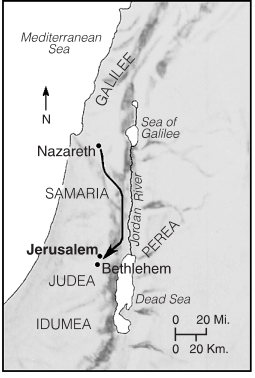
Joseph and Mary’s Journey to Bethlehem
Caesar’s decree for a census of the entire Roman Empire made it necessary for Joseph and Mary to leave their hometown, Nazareth, and journey the 70 miles (112.6 kilometers) to the Judean village of Bethlehem.
Open Bible Data Home About News OET Key
OET OET-RV OET-LV ULT UST BSB MSB BLB AICNT OEB WEBBE WMBB NET LSV FBV TCNT T4T LEB BBE Moff JPS Wymth ASV DRA YLT Drby RV SLT Wbstr KJB-1769 KJB-1611 Bshps Gnva Cvdl TNT Wycl SR-GNT UHB BrLXX BrTr Related Topics Parallel Interlinear Reference Dictionary Search
A B C D E F G H I J K L M N O P Q R S T U V W XY Z
BETHLEHEM
1. “City of David” and the birthplace of Jesus Christ, five miles (8 kilometers) south of Jerusalem. This city is sometimes called Bethlehem-judah (KJB) or Ephrath (Gn 35:19; Mi 5:2) to distinguish it from the Bethlehem of Zebulun.
As an early Canaanite settlement, it was associated with the patriarchs, for Rachel died and was buried in its vicinity (Gn 35:16, 19; 48:7). The earliest known historical reference to Bethlehem occurs in the Amarna texts (14th century BC) in which battle reports refer to bitil u-lahama south of Jerusalem. The name may have meant “house of (the goddess) Lahama.” A branch of Caleb’s family settled there, and Caleb’s son Salma was known as “the father of Bethlehem” (1 Chr 2:51). Bethlehem was the home of a young Levite who served as priest to Micah (Jgs 17:7-8), and of Boaz, Ruth, Obed, and Jesse, the Bethlehemite, David’s father (Ru 4:11, 17; 1 Sm 16:18).
Bethlehem was the birthplace of David (1 Sm 17:12) and the home of one of David’s mighty men, Elhanan (2 Sm 23:24; 1 Chr 11:26). It was the scene of a daring exploit by three of David’s warriors; they broke through the cordon of Philistine marauders occupying Bethlehem to bring David water from the well (or cistern) near the city gate of his hometown (2 Sm 23:14-17). Much later, Bethlehem is mentioned as being adjacent to the village of Geruth-kimham, where Jews fleeing from the Babylonians stayed en route to Egypt (Jer 41:17). People from Bethlehem were among those returning from the Babylonian exile (Ezr 2:21; Neh 7:26; 1 Esd 5:17).
When Jesus was born there, Bethlehem was only a village (Mt 2:1-16; Lk 2:4-6, 15; Jn 7:42). Under the census decree of Caesar Augustus, Joseph had to go to Bethlehem “because he was of the house and lineage of David” (Lk 2:4). The family may still have had property there. The birth of Jesus possibly took place in a cave in the rocks outside the town. The early Christian writer Justin Martyr thought so, as did Origen some years later. Origen frequently resided in the Holy Land and wrote, “In Bethlehem you are shown the cave where he was born, and within the cave the manger where he was wrapped in swaddling clothes.”
Jerome later described the grotto over which the Emperor Constantine had built a basilica. In excavations in 1934–35, evidence indicated a second period of building in the reign of Justinian (AD 527–565), when Constantine’s basilica was extended beyond its original proportions. Steps lead down to the grotto, the rectangular shape of which suggests that Constantine’s builders reshaped the original. But there is no description of the grotto prior to the construction of Constantine’s basilica.
2. Town in Zebulun (Jos 19:15), probably the home of the judge Ibzan (Jgs 12:8-10), an early ruler of Israel. It is identified today with the village of Beit Lahm, some seven miles (11.3 kilometers) northwest of Nazareth.

Joseph and Mary’s Journey to Bethlehem
Caesar’s decree for a census of the entire Roman Empire made it necessary for Joseph and Mary to leave their hometown, Nazareth, and journey the 70 miles (112.6 kilometers) to the Judean village of Bethlehem.